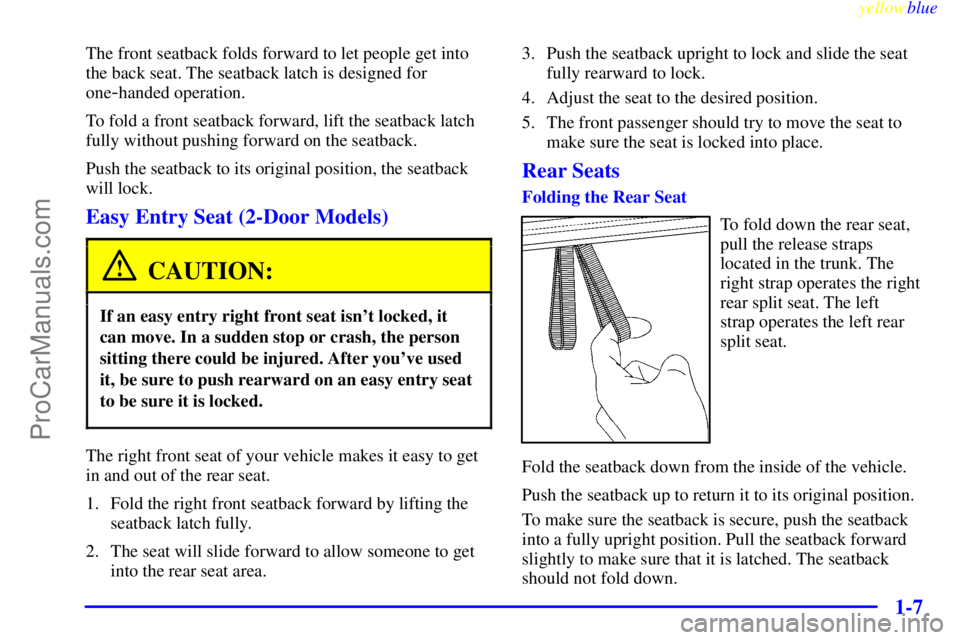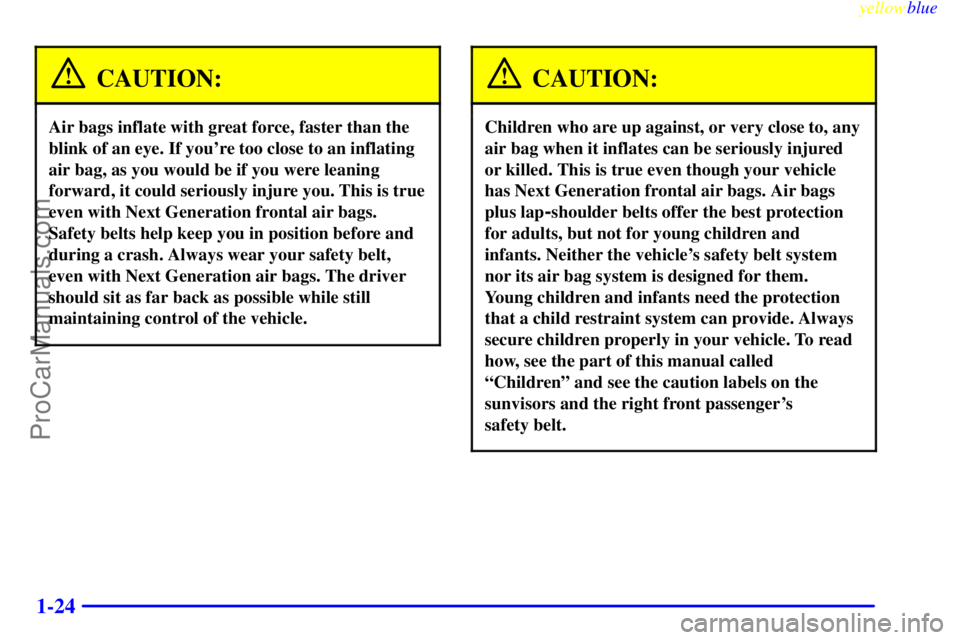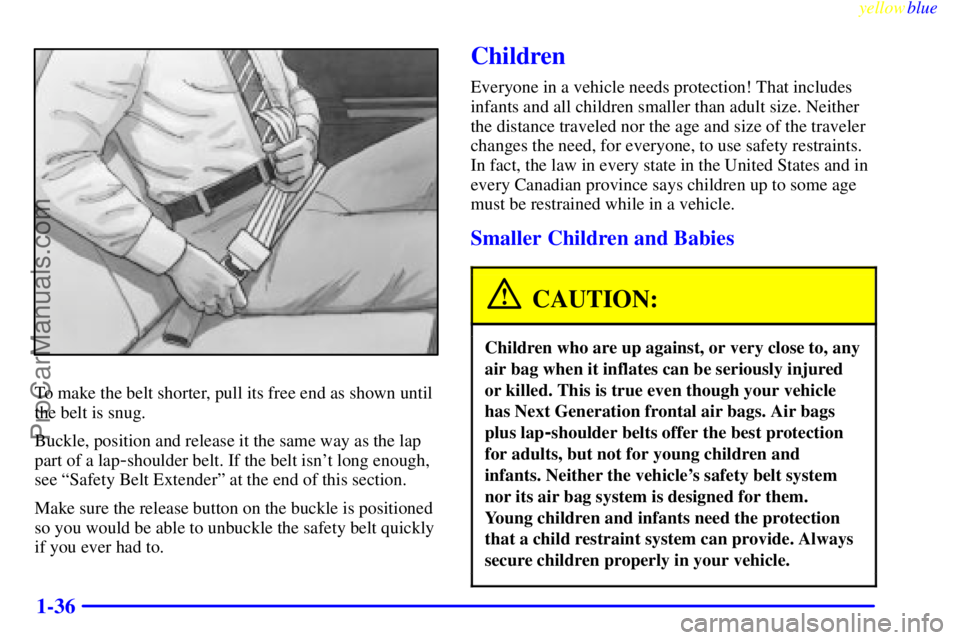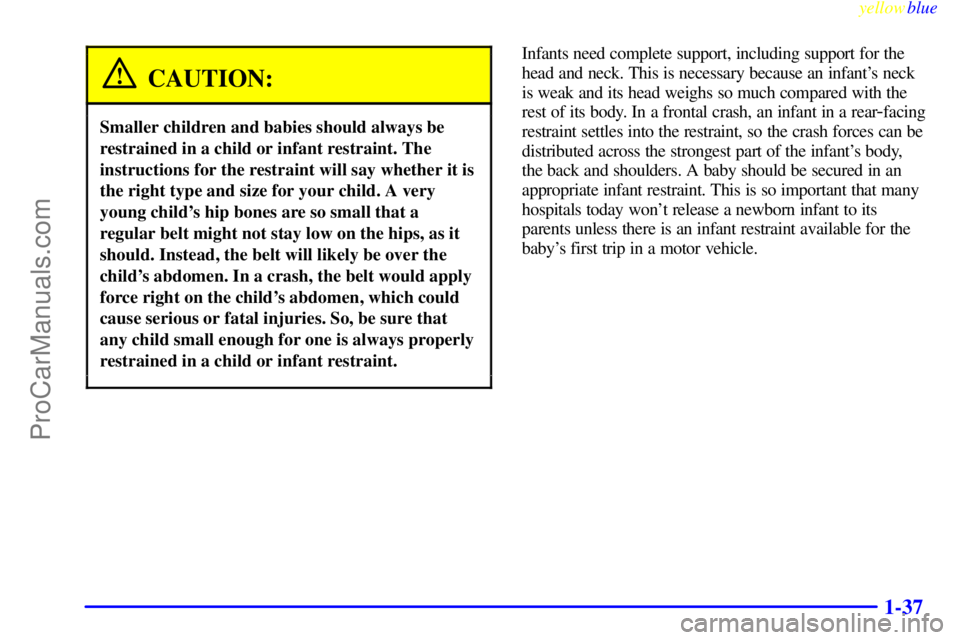Page 13 of 328

yellowblue
1-7
The front seatback folds forward to let people get into
the back seat. The seatback latch is designed for
one
-handed operation.
To fold a front seatback forward, lift the seatback latch
fully without pushing forward on the seatback.
Push the seatback to its original position, the seatback
will lock.
Easy Entry Seat (2-Door Models)
CAUTION:
If an easy entry right front seat isn't locked, it
can move. In a sudden stop or crash, the person
sitting there could be injured. After you've used
it, be sure to push rearward on an easy entry seat
to be sure it is locked.
The right front seat of your vehicle makes it easy to get
in and out of the rear seat.
1. Fold the right front seatback forward by lifting the
seatback latch fully.
2. The seat will slide forward to allow someone to get
into the rear seat area.3. Push the seatback upright to lock and slide the seat
fully rearward to lock.
4. Adjust the seat to the desired position.
5. The front passenger should try to move the seat to
make sure the seat is locked into place.
Rear Seats
Folding the Rear Seat
To fold down the rear seat,
pull the release straps
located in the trunk. The
right strap operates the right
rear split seat. The left
strap operates the left rear
split seat.
Fold the seatback down from the inside of the vehicle.
Push the seatback up to return it to its original position.
To make sure the seatback is secure, push the seatback
into a fully upright position. Pull the seatback forward
slightly to make sure that it is latched. The seatback
should not fold down.
ProCarManuals.com
Page 21 of 328
yellowblue
1-15
If the belt stops before it reaches the buckle, tilt the latch
plate and keep pulling until you can buckle the belt.
Pull up on the latch plate to make sure it is secure.
If the belt isn't long enough, see ªSafety Belt
Extenderº at the end of this section.
Make sure the release button on the buckle is
positioned so you would be able to unbuckle the
safety belt quickly if you ever had to.5. To make the lap part tight, pull down on the buckle
end of the belt as you pull up on the shoulder belt.
ProCarManuals.com
Page 30 of 328

yellowblue
1-24
CAUTION:
Air bags inflate with great force, faster than the
blink of an eye. If you're too close to an inflating
air bag, as you would be if you were leaning
forward, it could seriously injure you. This is true
even with Next Generation frontal air bags.
Safety belts help keep you in position before and
during a crash. Always wear your safety belt,
even with Next Generation air bags. The driver
should sit as far back as possible while still
maintaining control of the vehicle.
CAUTION:
Children who are up against, or very close to, any
air bag when it inflates can be seriously injured
or killed. This is true even though your vehicle
has Next Generation frontal air bags. Air bags
plus lap
-shoulder belts offer the best protection
for adults, but not for young children and
infants. Neither the vehicle's safety belt system
nor its air bag system is designed for them.
Young children and infants need the protection
that a child restraint system can provide. Always
secure children properly in your vehicle. To read
how, see the part of this manual called
ªChildrenº and see the caution labels on the
sunvisors and the right front passenger's
safety belt.
ProCarManuals.com
Page 36 of 328
yellowblue
1-30
Lap-Shoulder Belt
The positions next to the windows have lap
-shoulder
belts. Here's how to wear one properly.
1. Pick up the latch plate and pull the belt across you.
Don't let it get twisted.
The shoulder belt may lock if you pull the belt across
you very quickly. If this happens, let the belt go back
slightly to unlock it. Then pull the belt across you
more slowly.2. Push the latch plate into the buckle until it clicks.
If the belt stops before it reaches the buckle, tilt the
latch plate and keep pulling until you can buckle it.
Pull up on the latch plate to make sure it is secure.
If the belt is not long enough, see ªSafety Belt
Extenderº at the end of this section. Make sure the
release button on the buckle is positioned so you
would be able to unbuckle the safety belt quickly if
you ever had to.
ProCarManuals.com
Page 42 of 328

yellowblue
1-36
To make the belt shorter, pull its free end as shown until
the belt is snug.
Buckle, position and release it the same way as the lap
part of a lap
-shoulder belt. If the belt isn't long enough,
see ªSafety Belt Extenderº at the end of this section.
Make sure the release button on the buckle is positioned
so you would be able to unbuckle the safety belt quickly
if you ever had to.
Children
Everyone in a vehicle needs protection! That includes
infants and all children smaller than adult size. Neither
the distance traveled nor the age and size of the traveler
changes the need, for everyone, to use safety restraints.
In fact, the law in every state in the United States and in
every Canadian province says children up to some age
must be restrained while in a vehicle.
Smaller Children and Babies
CAUTION:
Children who are up against, or very close to, any
air bag when it inflates can be seriously injured
or killed. This is true even though your vehicle
has Next Generation frontal air bags. Air bags
plus lap
-shoulder belts offer the best protection
for adults, but not for young children and
infants. Neither the vehicle's safety belt system
nor its air bag system is designed for them.
Young children and infants need the protection
that a child restraint system can provide. Always
secure children properly in your vehicle.
ProCarManuals.com
Page 43 of 328

yellowblue
1-37
CAUTION:
Smaller children and babies should always be
restrained in a child or infant restraint. The
instructions for the restraint will say whether it is
the right type and size for your child. A very
young child's hip bones are so small that a
regular belt might not stay low on the hips, as it
should. Instead, the belt will likely be over the
child's abdomen. In a crash, the belt would apply
force right on the child's abdomen, which could
cause serious or fatal injuries. So, be sure that
any child small enough for one is always properly
restrained in a child or infant restraint.
Infants need complete support, including support for the
head and neck. This is necessary because an infant's neck
is weak and its head weighs so much compared with the
rest of its body. In a frontal crash, an infant in a rear
-facing
restraint settles into the restraint, so the crash forces can be
distributed across the strongest part of the infant's body,
the back and shoulders. A baby should be secured in an
appropriate infant restraint. This is so important that many
hospitals today won't release a newborn infant to its
parents unless there is an infant restraint available for the
baby's first trip in a motor vehicle.
ProCarManuals.com
Page 44 of 328
yellowblue
1-38
CAUTION:
Never hold a baby in your arms while riding in a
vehicle. A baby doesn't weigh much
-- until a
crash. During a crash a baby will become so
heavy you can't hold it. For example, in a crash
CAUTION: (Continued)
CAUTION: (Continued)
at only 25 mph (40 km/h), a 12-lb. (5.5 kg) baby
will suddenly become a 240
-lb. (110 kg) force on
your arms. The baby would be almost impossible
to hold.
Secure the baby in an infant restraint.
ProCarManuals.com
Page 46 of 328
yellowblue
1-40
A rear-facing infant restraint (B) positions an infant
to face the rear of the vehicle. Rear
-facing infant
restraints are designed for infants of up to about
20 lbs. (9 kg) and about one year of age. This type
of restraint faces the rear so that the infant's head,
neck and body can have the support they need in
a frontal crash. Some infant seats come in two
parts
-- the base stays secured in the vehicle and
the seat part is removable.
ProCarManuals.com